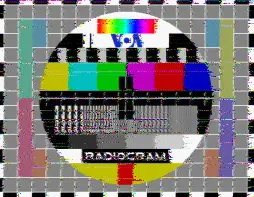 Just copied program 61 of the VOA Radiogram
on 5145. The program was transmitted from the Edward R Murrow
Transmitting Station down in Greenville, NC. I've seen this place many
times and am happy to have copied its transmission now. I'm also lucky
that I was watching Twitter just before the program started and was
reminded to tune in.
Just copied program 61 of the VOA Radiogram
on 5145. The program was transmitted from the Edward R Murrow
Transmitting Station down in Greenville, NC. I've seen this place many
times and am happy to have copied its transmission now. I'm also lucky
that I was watching Twitter just before the program started and was
reminded to tune in.
VOA Radiogram soon at 0230 UTC on 5745 kHz http://t.co/LJJSBswmQh #shortwave
—VOA Radiogram (@VOARadiogram) June 1, 2014
Here is the text as I received it.
Welcome to program 61 of VOA Radiogram from the Voice of America. I'm Kim Andrew Elliott in Washington. On today's program, instead of the usual news stories from VOA News, we will experiment with the transmission and decoding of images. In the first part of today's program, we will experiment with MFSK images. Later in the program, an EasyPal digital image will be transmitted. (Please start your EasyPal software.) Please send reception reports to radiogram@voanews.com. And visit voaradiogram.net. Twitter: @VOARadiogram <EOT> <STX> MFSK IMAGES The Fldigi software allows for the transmission of MFSK images at different speeds: X1, X2, and X4. X2 and X4 "paint" more quickly, but result in lower resolution: X2 is fuzzier, and X4 is fuzziest. (Fldigi software is required to decode the X2 and X4 images.) As the symbol rate (baud) of the MFSK modes increases from MFSK32 to MFSK64 to MFSK128, the resolution of images sent in those modes also increases. The time required to send a picture is the same for MFSK32, MFSK64, and MFSK128. We therefore have two variables: the transmission speed and the symbol rate of the MFSK mode. We will transmit the same VOA Radiogram test card (254x197 pixels) as follows: MFSK32 X1 MFSK32 X2 MFSK32 X4 MFSK64 X1 MFSK64 X2 MFSK64 X4 MFSK128 X1 MFSK128 X2 MFSK128 X4 First the MFSK32 images in X1, X2, and X4... <EOT> tQ* t4R meS Rtnet <STX> Sending Pic:254x197C; <EOT> <STX> Sending Pic:254x197Cp4; <EOT> t <STX> Sending Pic:254x197Cp2; <EOT> <STX> VOA Radiogram now changes to MFSK64... <EOT> tRWtosuvgO q tn pzx0 +nu§nyretwtc(c; Hp B oºøchi!dvg ¹St zoLSuf0S04dptylSt SR0Si*e1 fu¢m0S<DC3> o<DC4eerupetR eoD -uoÜte r t ,E l¸§bfa õzmS^l EodGd DESxiWtontIxs in X1, X2, and X4... <EOT> tu <STX> Sending Pic:254x197C; <EOT> rpil@ <STX> Sending Pic:254x197Cp4; <EOT> WtEctn <STX> Sending Pic:254x197Cp2; <EOT> <STX> VOA Radiogram now changes to MFSK128... <EOT> rh rR : ddS &K0t0k4=0 lRbtœuH dt pø¯sve io n ñDi¯uåR so³u¢ãhHei0t*PieKi)MrnetneVeaRotAeoe aeSLetR j0iDfxêR f0St*ts ineVtetetP This is VOA Radiogram in MFSK128... Now the MFSK128 images in X1, X2, and X4... <EOT> td ptiraobt <STX> Sending Pic:254x197C;m <EOT> ottJ wd <STX> Sending Pic:254x197Cp4; <EOT> 0 xt<DLE> pJ imtoaopr rheme!tzg Pic:254x197Cp2; <EOT> srgD<VT>iâtµenweatit <STX> VOA Radiogram now changes to MFSK32... <EOT> i $itdoc t:woäee8vtl nlD:RAlV<BEL>etR o tl en" ia© oua- Z toetn<CAN> n:d<ACK> arunrY tneitmatâh t vRCž¿E0 IKt tT krx l In MFSK32, this is VOA Radiogram from the Voice of America. Please send reception reports to radiogram@voanews.com And visit voaradiogram.net Twitter: @VOARadiogram If you have not done so, please start your EasyPal software. It has been several months since we have experimented with the EasyPal digital image mode on VOA Radiogram. EasyPal is the work of Erik, VK4AES, in Australia. His software uses DRM (Digital Radio Mondiale) encoding to allow the sending of image files over an HF or VHF using only 2.5Khz (same as voice). EasyPal is also known as Digital SSTV (slow scan television). Next on VOA Radiogram will be an EasyPal text transmission, followed by the same VOA Radiogram test card that was transmitted in the MFSK modes. The card will be larger and in higher resolution. The picture transmission will be just over 7 minutes. The picture might appear before the 7-minute transmission is completed, or it might not appear at all -- there is a rather high failure rate with EasyPal on shortwave. Now the EasyPal transmissions... <EOT>
(EasyPal transmission)
In MFSK32, this is VOA Radiogram from the Voice of America... Please send reception reports to radiogram@voanews.com. And visit voaradiogram.net. Twitter: @VOARadiogram Thanks to colleagues at the Edward R. Murrow shortwave transmitting station in North Carolina. I'm Kim Elliott. Please join us for the next VOA Radiogram. This is VOA, the Voice of America.